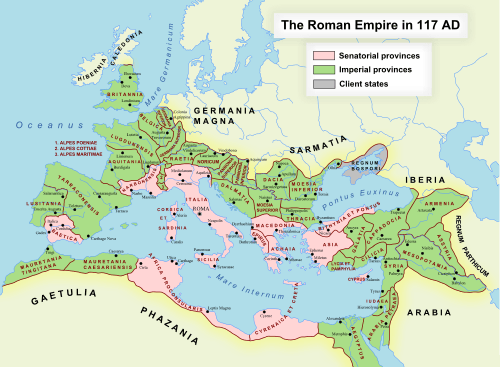Pannonia Superior
Pannonia Superior, lit. Upper Pannonia, was a province of the Roman Empire. Its capital was Carnuntum. It was one on the border provinces on the Danube. It was formed in the year 103 AD by Emperor Trajan who divided the former province of Pannonia into two parts: Pannonia Superior and Pannonia Inferior. The province included parts of present-day states of Austria, Croatia, Hungary, Slovakia, and Slovenia.
| Provincia Pannonia Superior | |||||||||||
|---|---|---|---|---|---|---|---|---|---|---|---|
| Province of the Roman Empire | |||||||||||
| 103–3rd century | |||||||||||
.svg.png) The province of Pannonia Superior within the Roman Empire, c. 125 AD | |||||||||||
| Capital | Carnuntum | ||||||||||
| History | |||||||||||
• Established | 103 | ||||||||||
• Disestablished | 3rd century | ||||||||||
| |||||||||||
History
It was as governor of the province that Septimius Severus made his bid for the Roman Imperial throne in April 193 CE.
In 308 Emperor Diocletian chaired a historic meeting with his co-emperors Maximian and Galerius in Carnuntum, to solve the rising tensions within the Tetrarchy. Diocletian and Maximian were both present on 11 November 308, to see Galerius appoint Licinius to be Augustus in place of Valerius Severus, who had died at the hands of Maxentius. Galerius ordered Maximian, who had attempted to return to power after his own retirement, to step down permanently. At Carnuntum people begged Diocletian to return to the throne, to resolve the conflicts that had arisen through Constantine the Great's rise to power and Maxentius' usurpation.[1] Diocletian's reply: "If you could show the cabbage that I planted with my own hands to your emperor, he definitely wouldn't dare suggest that I replace the peace and happiness of this place with the storms of a never-satisfied greed."[2]
Cities
Some of the important cities in Upper Pannonia were:
- Vindobona (today Vienna in Austria)
- Siscia (today Sisak in Croatia)
- Iovia Botivo (today Ludbreg in Croatia)
- Aquae Balissae (today Daruvar in Croatia)
- Andautonia (today Ščitarjevo in Croatia)
- Savaria (today Szombathely in Hungary)
- Scarbantia (today Sopron in Hungary)
- Arrabona (today Győr in Hungary)
- Poetovio (today Ptuj in Slovenia)
Later usage
The northern part of the 8th-century Frankish March of Pannonia was also called Upper Pannonia. The name can be found even much later in a similar, but wider, meaning. E.g. Otto von Freising (Chron. 6, 15) uses it to refer to Austria (i.e. Austria proper) in the 12th century.
List of Roman governors
- Publius Metilius Nepos 106-107/8[3]
- Lucius Minicius Natalis 113/114-117/118
- Lucius Cornelius Latinianus c. 126[4]
- Cornelius Proculus 130/131-133/134
- Lucius Aelius Caesar 136-137
- Titus Haterius Nepos 137-c. 141[5]
- Marcus Pontius Laelianus Larcius Sabinus c. 145-c. 150
- Claudius Maximus c. 150-c. 155
- Marcus Nonius Macrinus c. 159-c. 162
- Lucius Dasumius Tullius Tuscus c. 162-c. 166
- Marcus Iallus Bassus Fabius Valerianus c. 166-c. 169
- Gaius Julius Commodus Orfitianus c. 169-c. 172
- Sextus Quintilius Maximus c. 175-c. 179
- Septimius Severus c. 191
See also
- Pannonia
- Roman provinces
- Roman Empire
References
- Barnes, Constantine and Eusebius, 31–32; Lenski, 65; Odahl, 90.
- Aurelius Victor, Epitome de Caesaribus 39.6.
- Unless otherwise noted, governors from 103 to 137 are taken from Werner Eck, "Jahres- und Provinzialfasten der senatorischen Statthalter von 69/70 bis 138/139", Chiron, 12 (1982), pp. 281-362; 13 (1983), pp. 147-237
- Margaret Roxan and Paul Holder, Roman Military Diplomas IV, published as Bulletin of the Institute of Classical Studies. Supplement, No. 82 (2003), pp. 463f
- Unless otherwise noted, governors from 137 to 179 are taken from Géza Alföldy, Konsulat und Senatorenstand unter der Antoninen (Bonn: Rudolf Habelt Verlag, 1977), pp. 235-238
Sources
- Epitome de Caesaribus (translation) ca. 395.
- Barnes, Timothy D., Constantine and Eusebius. Cambridge, Massachusetts: Harvard University Press, 1981. ISBN 978-0-674-16531-1
- Lenski, Noel. "The Reign of Constantine." In The Cambridge Companion to the Age of Constantine, edited by Noel Lenski, 59–90. New York: Cambridge University Press, 2006. Hardcover ISBN 0-521-81838-9 Paperback ISBN 0-521-52157-2
- Odahl, Charles Matson. Constantine and the Christian Empire. New York: Routledge, 2004. Hardcover ISBN 0-415-17485-6 Paperback ISBN 0-415-38655-1
